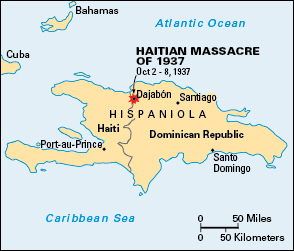Haitian Massacre of 1937 was the mass killing of thousands of Haitians in the Dominican Republic. The nations of Haiti and the Dominican Republic share the island of Hispaniola in the Caribbean Sea. Dominican military personnel and some civilians carried out the Haitian Massacre from October 2 to October 8, 1937. At that time, President Rafael Trujillo ruled the Dominican Republic as a dictator. Victims of the massacre included both people of Haitian nationality living in the Dominican Republic and Dominicans with Haitian ancestry.

Most of the murders took place near the northern part of the Haitian-Dominican border. However, Haitians also were rounded up and killed as far away as the city of Santiago, about 60 miles (97 kilometers) east of the border. The border area where most of the killings took place is marked by the Massacre River, also called the Dajabón River. (The Massacre River was not named for the 1937 massacre, but rather for a violent clash between Spanish forces and French colonists in the early 1700’s.) Haitians working on American-owned sugar plantations were not hurt.
The killers mostly used clubs and machetes, though some victims were shot. The choice in weapons was likely intended to make observers think that private citizens, not government forces, were responsible.
Historians have attributed the massacre to Trujillo’s desire to “cleanse” the Dominican borderlands of Haitian migrants, to enforce the rule of the Dominican state, and to deal with Haitian cattle rustlers and crop thieves. It is generally accepted that Trujillo personally ordered the massacre. However, there is no evidence of orders or preparation for the massacre in Dominican government records. Official Dominican military reports do not mention any notable incidents at the time of the massacre.
Estimates of the number of dead range from about 2,000 to as many as 25,000. An unknown number of people fled across the border into Haiti. A lack of evidence has cast doubt on some of the casualty estimates. Some people believe that Trujillo’s political opponents and Dominican exiles inflated the numbers to discredit Trujillo’s regime.
The Haitian Massacre is sometimes called the “Parsley Massacre,” after a widely held myth. According to stories at the time, Dominican authorities used parsley leaves in a test to differentiate Haitians from black Dominicans. In Spanish, the language of the Dominican Republic, the word for parsley is perejil. Haitians, who spoke French or Creole, would have difficulty pronouncing the word. Thus, if a detainee could not pronounce perejil correctly, he or she was assumed to be Haitian and killed. Many historians doubt that such tests were widely used.
The massacre sparked a major diplomatic crisis between Haiti and the Dominican Republic. Trujillo did not deny that the murders had occurred. However, he attributed them to Dominican civilians who were tired of being robbed by Haitians. Other Latin American countries and the United States helped mediate the crisis. The Dominican government agreed to pay more than half a million U.S. dollars in compensation, which was supposed to be divided among survivors of the massacre and relatives of those killed.
The Haitian Massacre exposed the brutality of Trujillo’s dictatorship to people outside the Dominican Republic, particularly in the United States. Still, Trujillo remained in power and continued to rule harshly until his death in 1961.
See also Dominican Republic; Haiti; Hispaniola; Trujillo Molina, Rafael Leonidas.
